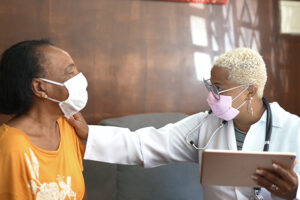Oncology
Chronic Myeloid Leukemia
Evolving Practices in the Treatment of Chronic Myeloid Leukemia
Overview
The treatment of chronic phase chronic myeloid leukemia (CML) is evolving in response to newer data on BCR::ABL1 tyrosine kinase inhibitors (TKIs). At the 64th ASH Annual Meeting and Exposition, researchers shared their ongoing work to optimize each line of therapy in CML.
Following these presentations, featured expert Hagop M. Kantarjian, MD, was interviewed by Conference Reporter Editor-in-Chief Tom Iarocci, MD. Dr Kantarjian’s clinical perspectives on these findings are presented here.
Hagop M. Kantarjian, MDProfessor and Samsung Distinguished Leukemia Chair in Cancer Medicine |
|
“Practices in CML are evolving in a number of areas, including the current pursuit of TFRs and the development and incorporation of newer BCR::ABL1 TKIs for patients with treatment failure due to TKI resistance or intolerance.”
Practices in CML are evolving in a number of areas, including the current pursuit of treatment-free remissions (TFRs) and the development and incorporation of newer BCR::ABL1 TKIs for patients with treatment failure due to TKI resistance or intolerance.
With regard to TFR, we reported in the American Journal of Hematology that the estimated 5-year TFR rates were higher with MR4 and MR4.5 lasting for 5 years or longer compared with MR4 lasting for less than 5 years (87% vs 92% vs 64%). These data are fairly recent, and it may take some time for the findings to affect clinical practice. CML experts are moving toward recommending a sustained deep molecular response for at least 5 years, although other durations are still being discussed and evaluated.
In addition, several recent studies have addressed treatment failure due to TKI resistance and intolerance, investigating different TKIs and dosing strategies as treatment options.
When a patient experiences treatment failure due to side effects, TKI dose reductions can be considered when the toxicity is not considered high risk or life threatening. In such cases, imatinib can be reduced from 400 mg per day to 200 mg per day, dasatinib can be reduced from 100 mg per day to 50 mg per day (or even 20 mg/day), bosutinib can be reduced from 500 mg per day to 200 to 400 mg per day, nilotinib can be reduced from 300 to 400 mg twice per day to 200 mg per day or 150 to 200 mg twice per day, and, lastly, ponatinib can be reduced from 45 mg per day to 15 to 30 mg per day.
Examples of prohibitive toxicities that preclude the consideration of the same TKI at a lower dosing schedule include the development of pancreatitis, pulmonary hypertension, pericardial effusions, immune-mediated pneumonitis, significant neurotoxicity, colitis, and arterial occlusive events or vaso-occlusive events. In such instances, switching to a different TKI therapy is advised.
If a patient on first-line imatinib experiences treatment failure due to resistance, we consider a switch to a second-generation agent. If a patient develops resistance to a second-generation TKI in the absence of a guiding mutation, rotating to other second-generation TKIs yields poor benefits. In such cases, the consideration of a third-generation TKI is preferred. The 2 currently available third-generation TKIs are ponatinib and asciminib. Both agents are considered more potent than second-generation TKIs. In abstract 333 from this year’s ASH conference, we argued, based on our experience, that ponatinib also improves survival as third-line therapy in CML compared with second-generation TKIs.
In abstracts 333 and 620, it was reported that dose-optimized ponatinib is a good treatment option for patients with treatment failure on second-generation TKI therapy. The US Food and Drug Administration (FDA) initially approved ponatinib at a dose of 45 mg per day, which may cause side effects such as hypertension, pancreatitis, arterial occlusive events, and skin rashes. Lower doses of ponatinib (15-30 mg/day) are better tolerated, and the data suggest that we can reduce the dose of ponatinib to 15 mg daily once a complete cytogenetic response (CCyR; polymerase chain reaction <1%) is achieved.
Patients experiencing treatment failure on second-generation TKIs may also be candidates for asciminib, which received FDA approval in 2021 for CML treated previously with 2 or more TKIs. Asciminib is a potent BCR::ABL1 inhibitor with a novel allosteric mode of action. It targets the ABL myristoyl pocket and is therefore referred to as a STAMP inhibitor (Specifically Targeting the ABL Myristoyl Pocket). Some CML experts are enthusiastic about asciminib because it targets a different area of the BCR::ABL1 kinase—an area where resistance mutations associated with classical BCR::ABL1 TKIs do not occur. However, mutations in the myristoyl pocket are now being reported in patients on asciminib therapy (abstract 4323).
Asciminib is being investigated in earlier lines of treatment, as reported in abstracts 79 and 80 at the meeting. Further, the findings from several ASH 2022 abstracts have added to the knowledge base of asciminib in heavily pretreated CML. For example, Turkina et al reported 2-year updated results of 50 patients treated with asciminib in the Managed Access Program in Russia (abstract 4342). They reported favorable responses and side-effect profiles.
Pérez-Lamas and colleagues presented their retrospective study of 77 patients with CML from 36 Spanish centers who experienced therapeutic failure with second-generation TKIs and received asciminib through a compassionate use program (abstract 1708). They found that asciminib was associated with a good safety profile, with a lower rate of adverse events compared with classical TKIs. However, they also reported evidence of cross-intolerance with classical TKIs for some toxicities, including hematologic toxicity, fatigue, vomiting, and pancreatitis.
Three abstracts from the ASH meeting updated the results with olverembatinib (HQP1351), a novel third-generation BCR::ABL1 TKI that was developed in China and has received regulatory approval in China for the treatment of CML post 2 TKI failures (abstracts 81, 82, and 83). It is currently being investigated in the United States.
In abstract 81, 101 patients with chronic phase CML (n = 86) or accelerated phase CML (n = 15) were treated with olverembatinib. Approximately 83% of patients had received 2 or more lines of TKI therapy and approximately 62% had a T315I mutation. In evaluable patients with chronic phase CML, the CCyR rate was 71.3%, the major molecular response (MMR) rate was 55.3%, and the estimated 4-year progression-free survival rate was 85.6%.
Jiang et al detailed the results of pivotal phase 2 trials of olverembatinib in T315I-mutated chronic phase and accelerated phase CML involving 64 patients (abstract 83). In the 41 individuals with chronic phase CML, the MMR rate was 58.5% and the 3-year overall survival rate was 95.1%.
Finally, in abstract 82 (the US study), among 30 patients with chronic phase or accelerated phase CML (3 prior TKIs in 24 of 30 patients, prior ponatinib therapy in 21 of 30 patients, and ponatinib resistance in 17 of 21 patients) treated with olverembatinib 30 to 50 mg every other day, the CCyR rate was approximately 59% and the MMR rate was approximately 43% among evaluable patients. CCyR was noted in 5 of 9 evaluable patients with prior ponatinib resistance.
In summary, there are now several third-generation TKIs that may offer significant value in CML post multiple TKI failures. These include ponatinib and asciminib, which are FDA approved; olverembatinib, which is approved in China and is being investigated in ongoing trials elsewhere; and others that are under investigation.
References
Cortes JE, Deininger MW, Lomaia E, et al. Three-year update from the OPTIC trial: a dose-optimization study of 3 starting doses of ponatinib [abstract 620]. Abstract presented at: 64th American Society of Hematology Annual Meeting and Exposition; December 10-13, 2022; New Orleans, LA.
Cortes JE, Hughes T, Geissler J, et al. Efficacy and safety results from ASC4MORE, a randomized study of asciminib (ASC) add-on to imatinib (IMA), continued IMA, or switch to nilotinib (NIL) in patients (pts) with chronic-phase chronic myeloid leukemia (CML-CP) not achieving deep molecular responses (DMRs) with ≥1 year of IMA [abstract 80]. Abstract presented at: 64th American Society of Hematology Annual Meeting and Exposition; December 10-13, 2022; New Orleans, LA.
Haddad FG, Sasaki K, Issa GC, et al. Treatment-free remission in patients with chronic myeloid leukemia following the discontinuation of tyrosine kinase inhibitors. Am J Hematol. 2022;97(7):856-864. doi:10.1002/ajh.26550
Jabbour E, Koller PB, Oehler VG, et al. Olverembatinib (HQP1351) overcomes ponatinib resistance in patients with heavily pretreated/refractory chronic myeloid leukemia (CML) and Philadelphia chromosome-positive acute lymphoblastic leukemia (Ph+ ALL) [abstract 82]. Abstract presented at: 64th American Society of Hematology Annual Meeting and Exposition; December 10-13, 2022; New Orleans, LA.
Jabbour E, Sasaki K, Issa GC, et al. Outcome of third-line tyrosine kinase inhibitors in patients with chronic myeloid leukemia in chronic phase: a propensity score analysis [abstract 333]. Abstract presented at: 64th American Society of Hematology Annual Meeting and Exposition; December 10-13, 2022; New Orleans, LA.
Jiang Q, Li Z, Hou Y, et al. Updated results of pivotal phase 2 trials of olverembatinib (HQP1351) in patients (pts) with tyrosine kinase inhibitor (TKI)-resistant chronic- and accelerated-phase chronic myeloid leukemia (CML-CP and CML-AP) with T315I mutation [abstract 83]. Abstract presented at: 64th American Society of Hematology Annual Meeting and Exposition; December 10-13, 2022; New Orleans, LA.
Jiang Q, Li Z, Qin Y-Z, et al. A five-year follow-up on safety and efficacy of olverembatinib (HQP1351), a novel third-generation BCR-ABL tyrosine kinase inhibitor (TKI), in patients with TKI-resistant chronic myeloid leukemia (CML) in China [abstract 81]. Abstract presented at: 64th American Society of Hematology Annual Meeting and Exposition; December 10-13, 2022; New Orleans, LA.
Leyte-Vidal AM, Shah NP. Select P-loop mutants in BCR::ABL1 confer moderate to high degrees of resistance to asciminib [abstract 4323]. Abstract presented at: 64th American Society of Hematology Annual Meeting and Exposition; December 10-13, 2022; New Orleans, LA.
Pérez-Lamas L, Luna A, Boque C, et al. Toxicity of asciminib in real clinical practice; analysis of side effects and cross-intolerance with tyrosine kinase inhibitors [abstract 1708]. Abstract presented at: 64th American Society of Hematology Annual Meeting and Exposition; December 10-13, 2022; New Orleans, LA.
Turkina A, Kuzmina EA, Lomaia E, et al. Two-year updated results of asciminib Managed Access Program (MAP) in Russia [abstract 4342]. Abstract presented at: 64th American Society of Hematology Annual Meeting and Exposition; December 10-13, 2022; New Orleans, LA.
Yeung DT, Shanmuganathan N, Reynolds J, et al. Early and deep molecular responses achieved with frontline asciminib in chronic phase CML – interim results from ALLG CML13 ASCEND-CML [abstract 79]. Abstract presented at: 64th American Society of Hematology Annual Meeting and Exposition; December 10-13, 2022; New Orleans, LA.
This information is brought to you by Engage Health Media and is not sponsored, endorsed, or accredited by the American Society of Hematology.











